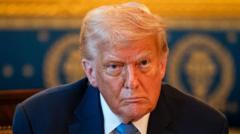Asia is facing a turbulent economic landscape as US President Donald Trump extends the deadline for tariff negotiations, creating a wave of uncertainty across the region. Japanese Prime Minister Shigeru Ishiba has condemned the proposed 25% tariff on Japanese goods as "deeply regrettable," reflecting Tokyo's struggle to protect its automotive sector while resisting pressure to open its rice markets to American imports.
Despite multiple negotiation sessions, including seven trips by Japan's trade minister to Washington since April, progress appears minimal. The newest tariff threat adds Japan to a growing list of 23 nations, with 14 of them hailing from Asia, that have received tariff notifications. Countries such as South Korea and Sri Lanka, reliant on export-driven industries, are anxiously tracking these developments.
Trump's latest announcement also included a 35% tariff on Canadian goods and an intention to increase tariffs from 10% to up to 20% on various trade partners. The backdrop of these moves is a deadline of August 1, creating a pressing situation for countries to negotiate favorable terms with the US. Observers are left pondering who stands to benefit or suffer from this evolving tariff landscape.
On one hand, the deadline extension grants negotiators vital time to enhance deals, especially for growing economies like Thailand and Malaysia, which are keen to navigate the effects of US-China trade tensions and potential tariffs on goods rerouted through third countries. However, such complexities in trade discussions signal that further negotiations may involve significant time and technological adaptations to manage supply chain intricacies.
The fallout from the tariffs seemingly positions Asian manufacturers as the primary victims of such economic strife. Experts suggest that the broader manufacturing landscape, including US imports and consumer markets, will bear the brunt of the repercussions stemming from these tariffs.
Countries like Vietnam and Cambodia, which have already pursued trade agreements, find themselves vulnerable, facing aggressive tariffs that threaten their export-dependent economies. Meanwhile, nations with more robust economies, such as Japan and South Korea, may navigate these pressures with greater resilience owing to their geopolitical advantages.
As tensions rise, the US-Japan alliance also appears strained. Despite their close relationship, Japan faces treatment akin to other Asian nations. This dynamic could alter future diplomatic relations, with Japan possibly poised to adopt a long-term strategy aimed at outmaneuvering US demands.
Analysts foresee that trade negotiations remain complex and nuanced, with the potential for both the US and China to reshape their economic influence in the region. The fluctuating stance of the US under Trump, further amplified by the unconventional posting of tariff letters online, has raised concerns about Washington's long-term negotiating power. As diplomatic efforts continue, it remains to be seen who will emerge as the winner in this intricate web of international trade relations.



















